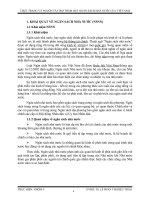Thiếu Hụt Ngân Sách Nhà Nước - Nguyễn Hồng Thắng
Bạn đang xem bản rút gọn của tài liệu. Xem và tải ngay bản đầy đủ của tài liệu tại đây (4.63 MB, 75 trang )
THIẾU HỤT NGÂN
SÁCH NHÀ NƯỚC
Nguyeãn Hoàng Thaéng, UEH
Nội dung
Hai quan điểm về chính sách tài chính:
– The Keynesian View
– The New Classical View
Thiếu hụt ngân sách nhà nước
– Quan điểm
– Phân loại
Nguyên nhân thiếu hụt ngân sách nhà nước
Tài trợ thiếu hụt ngân sách nhà nước
Nợ công
The Keynesian View of
Fiscal Policy
The Keynesian View of Fiscal
Policy
• Keynesian theory highlights the potential of fiscal
policy as a tool capable of reducing fluctuations in
aggregate demand.
• Following the Great Depression, Keynesians
challenged the view that governments should always
balance their budget.
– Rather than balancing their budget annually,
Keynesians argue that counter-cyclical policy
should be used to offset fluctuations in aggregate
demand.
– This implies that the government should
plan budget deficits when the economy is weak
and budget surpluses when strong demand
threatens to cause inflation.
Keynesian Policy To Combat
Recession
• When an economy is operating below
its potential output, the Keynesian
model suggests that the government
should institute expansionary fiscal
policy, by:
– increasing the government’s purchases
of goods & services, and/or,
– cutting taxes.
Expansionary Fiscal Policy
Price
Level
Keynesians believe that
allowing for the market to
self-adjust may be a lengthy
and painful process.
LRAS
SRAS2
E2
P2
P1
SRAS1
e1
P3
E3
Expansionary fiscal policy
stimulates demand and
directs the economy to
full-employment
AD1 AD2
Y1 YF
Goods & Services
(real GDP)
• At e1 (Y1), the economy is below its potential capacity YF .
There are 2 routes to long-run full-employment equilibrium:
– Wait for lower wages and resource prices to reduce costs, increase
supply to SRAS2 and restore equilibrium to E3, at YF.
– Alternatively, expansionary fiscal policy could stimulate
AD (shift to AD2) and guide the economy back to E2, at YF .
Keynesian Policy To Combat
Inflation
• When inflation is a potential problem,
Keynesian analysis suggests a shift
toward a more restrictive fiscal
policy by:
– reducing government spending, and/or,
– raising taxes.
Restrictive Fiscal Policy
Price
Level
P3
LRAS
SRAS1
E3
P1
P2
SRAS2
e1
E2
Restrictive fiscal policy
restrains demand and
helps control inflation.
AD2 AD1
YF Y1
Goods & Services
(real GDP)
• Strong demand such as AD1 will temporarily lead to an output
rate beyond the economy’s long-run potential YF.
– If maintained, the strong demand will lead to the long-run
equilibrium E3 at a higher price level (SRAS shifts to SRAS2).
– Restrictive fiscal policy could reduce demand to AD2 (or keep AD
from shifting to AD1 initially) and lead to equilibrium E2.
The New Classical View
of Fiscal Policy
The New Classical View of Fiscal
Policy
• The New Classical view stresses that:
– Tài trợ thâm hụt bằng nợ chỉ là việc đánh đổi các khoản thuế
cao trong tương lai bằng những khoản thuế thấp hiện nay
(debt financing merely substitutes higher future taxes for lower current taxes)
– Như vậy, thâm hụt ngân sách tác động đến thời gian đánh
thuế chứ không phải độ lớn của chúng (budget deficits affect the
timing of taxes, but not their magnitude).
• New Classical economists argue that when debt is substituted
for taxes:
– Mọi người tiết kiệm các khoản thu nhập gia tăng để trả thuế
cao hơn trong tương lai (people save the increased income so they will be
able to pay the higher future taxes)
– Như vậy, thâm hụt ngân sách không kích thích tổng cầu (the
budget deficit does not stimulate aggregate demand) .
The New Classical View
of Fiscal Policy
• Similarly, New Classical economists believe
that the real interest rate is unaffected by
deficits as people save more in order to pay
the higher future taxes.
• Xa hơn, họ tin rằng chính sách tài chính
công hoàn toàn bất lực, tức là không tác
động gì đến sản lượng, việc làm và lãi suất
thực. (Further, they believe fiscal policy is completely impotent –
that it does not affect output, employment, or real interest rates) .
Expansionary Fiscal Policy
Price
Level
SRAS1
P1
AD1
Y1
AD2
Goods & Services
(real GDP)
New Classical economists emphasize that budget deficits
merely substitute future taxes for current taxes.
If households did not anticipate the higher future taxes,
aggregate demand would increase (from AD1 to AD2).
However, when households fully anticipate the future taxes
and save for them, demand remains unchanged at AD1.
Expansionary Fiscal Policy
Loanable Funds
Market
Real
interest
rate
S1
S2
r1
e1
e2
Here, fiscal policy exerts
no effect on the interest rate,
real GDP, or unemployment.
D1
Q1
Q2
D2
Quantity of
loanable funds
• To finance the budget deficit, the government borrows from the
loanable funds market, increasing the demand (to D2).
• Under the new classical view, people save to pay expected higher
future taxes (raising the supply of loanable funds to S2.)
• This permits the government to borrow the funds to finance the
deficit without pushing up the interest rate.
Questions for Thought:
1. “When the federal government runs a budget
deficit, it finances the deficit by issuing
additional U.S. Treasury bonds.”
-- Is this statement true?
2. When an economy is operating below its
potential capacity, Keynesian economists argue
that
a. taxes should be raised if the government is
currently running a budget deficit.
b. the government should cut taxes and/or
increase expenditures in order to stimulate
aggregate demand.
c. government spending should be cut and the
budget shifted toward a surplus.
Questions for Thought:
3. The crowding out effect indicates that budget
deficits …
a. will stimulate aggregate demand and so exert
a strong impact on both output & employment.
b. will lead to additional borrowing and higher
interest rates that will reduce the level of
private spending.
4. “New classical economists stress that an
increase in government expenditures
financed by borrowing rather than taxes will
lead to higher interest rates.”
-- Is this statement true?
Tình trạng thiếu hụt ngân
sách nhà nước
Trạng thái chi NSNN vượt thu NSNN
trong một khoảng thời gian
Thiếu hụt NSNN và nợ công có mối
quan hệ mật thiết với nhau
Nợ công là một con số thời điểm. Thiếu
hụt NSNN là một con số thời kỳ.
Tổng các khoản thiếu hụt trong quá khứ
cộng dồn lại thành dư nợ hiện hành.
Công thức xác định nợ
Debt = RBt-1 + (r-g)Gt - Tt
– R= real interest rate.
– Bt-1= Debt of last year.
– r = Interest Rate
– g= growth rate
– Gt= Government Spending
– Tt = Tax Revenue.
Top Ten National Budgets (2004)
National Government Budgets for 2004 (In Billions of US$)
Nation
GDP
Revenue
Expenditure
Exp / GDP
Budget Deficit
Deficit / GDP
US (fed.)
11700
1862
2338
19.98%
-25.56%
-4.07%
-
900
850
7.6%
+5%
+0.4%
Japan
4600
1400
1748
38.00%
-24.86%
-7.57%
Germany
2700
1200
1300
48.15%
-8.33%
-3.70%
UK
2100
835
897
42.71%
-7.43%
-2.95%
France
2000
1005
1080
54.00%
-7.46%
-3.75%
Italy
1600
768
820
51.25%
-6.77%
-3.25%
China
1600
318
349
21.81%
-9.75%
-1.94%
Spain
1000
384
386
38.60%
-0.52%
-0.20%
Canada
900
150
144
16.00%
+4.00%
+0.67%
South
Korea
600
150
155
25.83%
-3.33%
-0.83%
US (state)
Nguồn: www.wikipedia.org/
Phân loại thiếu hụt NSNN
theo thời gian
Thiếu hụt NSNN trong ngắn hạn:
– Chi tiêu công mang tính thường xuyên
– Thuế thu chưa kòp
– Vay ngắn hạn
Thiếu hụt NSNN trong dài hạn:
–
–
–
–
Trong nhiều tài khoá
Cho thấy tình trạng suy kém của khu vực công
Vay dài hạn
Viện trợ khẩn cấp
Phân loại thiếu hụt NSNN
theo nguồn gốc
Thiếu hụt chu kỳ:
– Ảnh hưởng bởi những biến động kinh tế mang tính chu kỳ
– At the lowest point in the business cycle, there is a high level of
unemployment. This means that tax revenues are low and
expenditure (e.g. on social security) high. Conversely, at the peak of
the cycle, unemployment is low, increasing tax revenue and
decreasing social security spending. The need to borrow money at
the low point of the cycle is a cyclical deficit. A cyclical deficit will be
entirely repaid by a cycical surplus at the peak of the cycle.
Thiếu hụt cơ cấu:
– Chính phủ chủ động thay đổi chính sách kinh tế, tài chính
– A structural deficit is the deficit that remains across the business
cycle, because general tax levels are too low for the general level of
government spending.
Thiếu hụt cơ cấu
A structural deficit is the deficit that
remains across the business cycle, because
general tax levels are too low for the
general level of government spending.
Quan điểm cổ điển
Quan
điểm
về
thiếu
hụt
NSNN
Tiêu biểu: Adam Smith
Nội dung:
– Ủng hộ ngân sách cân bằng
– Chống thiếu hụt ngân sách vì thiếu hụt
NSNN đồng nghóa với nợ nần.
– Gánh nặng nợ sẽ dồn lên vai thế hệ sau.
Quan điểm hiện đại
Quan
điểm
về
thiếu
hụt
NSNN
Tiêu biểu: J.M. Keynes, P.A. Samuelson
Thời gian: 1929-1930
Nội dung:
– Chủ trương kích thích tiêu dùng
– Ủng hộ thiếu hụt
– Cắt giảm thuế và tăng chi công
– Có thể in thêm tiền
– Tăng vay nợ
Nguyên nhân gây thiếu hụt
NSNN
Chính phủ gia tăng vai trò của mình →
Chi tiêu công gia tăng trong khi thu nhập
công không hẳn do chính phủ chủ động
hoàn toàn.
Chính phủ chủ động điều chỉnh cơ cấu
kinh tế.
Điều hành tài chính công kém hiệu lực.
Tham nhũng.
Tài trợ thiếu hụt NSNN
Phát hành tiền
Giảm chi
Tăng thuế
Chống tham nhũng (bòt rò rỉ)
Vay nợ









